The O’Sullivan surname is of Irish origin. It is an Anglicized form of the Gaelic “Ó Súilleabháin,” which was the name of an important family in southern Ireland during medieval times.
Etymology and Meaning
The surname O’Sullivan is derived from the Gaelic “Ó Súilleabháin,” meaning “descendant of Súilleabhán.” The personal name Súilleabhán is composed of two elements: “súil,” meaning “eye,” and “dubh,” meaning “black,” along with “án,” a diminutive suffix.
Earliest Known Usage
The earliest known usage of the O’Sullivan surname dates back to the 13th century. The O’Sullivan clan traces its descent from Eoghan Mór, also known as Eugene the Great, who was a King of Munster in the late 3rd century.
Geographic Distribution
Today, the O’Sullivan surname is predominantly found in Ireland, particularly in County Cork and County Kerry, the original homeland of the clan. However, due to extensive Irish emigration over the centuries, bearers of the surname can be found worldwide, especially in the United States, the United Kingdom, Canada, and Australia.
Original Geographic Location
The O’Sullivan family originally held territories in the modern counties of Tipperary and Waterford, before being driven west to County Kerry and parts of County Cork during the Anglo-Norman invasion in the late 12th century. There, they established two main branches: O’Sullivan Mor, based in Dunkerron, south of Kenmare, in Kerry, and O’Sullivan Beare, on the Beara Peninsula in Cork.
Migration Patterns
The O’Sullivan surname spread beyond Ireland primarily during the 19th century, a period marked by the Great Famine, which led to mass migration. O’Sullivans left Ireland in large numbers for North America, Australia, and other parts of the British Empire, often in search of better living conditions.
Historical Context
Notable Historical Events
O’Sullivans were involved in several historical events, including their resistance to English rule during the late medieval period. The most notable event is the O’Sullivan Beare’s march in 1602-03, when following defeat in the Nine Years’ War, Donal Cam O’Sullivan Beare led his followers from their stronghold in County Cork to seek refuge in County Leitrim.
Involvement in Key Moments in History
In the modern era, O’Sullivans have participated in key moments in history, such as the Irish War of Independence (1919-1921), where several O’Sullivans played vital roles.
Notable Bearers of the Surname
Famous Individuals
Famous individuals with the O’Sullivan surname include Maureen O’Sullivan, an Irish-American actress who was famous for playing Jane in the Tarzan series of films during the early talkie era. Ronnie O’Sullivan, a world champion English snooker player, is another well-known bearer of the name.
Influential Figures
Influential figures include Donal Cam O’Sullivan Beare, the last independent lord of the O’Sullivan Beare, known for his aforementioned march, and Eoghan Rua Ó Súilleabháin, an 18th-century Irish poet.
Variations of the Surname
Spelling Variations
Spelling variations of the O’Sullivan surname include Sullivan, Sullavan, and O’Sullevan, among others. The prefix ‘O’, often dropped in the 17th and 18th centuries, has been widely restored in the modern era.
Regional Differences
There are regional differences in the prevalence of the surname within Ireland itself. The O’Sullivan name is most common in the Munster counties of Cork and Kerry, while Sullivan, without the ‘O’, is more common in County Limerick.
Current Statistics and Distribution
Frequency and Global Distribution
The O’Sullivan surname is the third most common surname in Ireland. According to recent census data, there are over 80,000 O’Sullivans in Ireland. Worldwide, there are an estimated 180,000 individuals with the O’Sullivan surname. Outside of Ireland, the surname is most frequent in the United States, United Kingdom, Australia, and Canada.
Changes Over Time
While the geographical distribution of the O’Sullivan surname has changed due to migration, its prevalence within Ireland has remained relatively stable. It has consistently ranked among the top Irish surnames for several centuries.
Family Coat of Arms
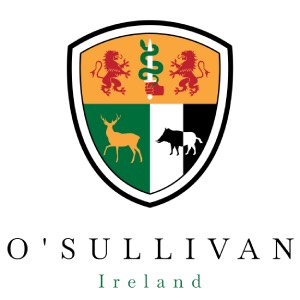
The O’Sullivan family crest is a complex and richly symbolic heraldic emblem that vividly illustrates the family’s values, heritage, and identity. The crest is divided into three sections, each featuring different colors and symbols that convey distinct meanings.
Yellow/Gold Section:
This upper section of the crest is colored in yellow or gold, traditionally representing generosity, wisdom, and elevation of the mind. Within this section, there is a red hand gripping a white sword, upon which a green snake is entwined. The red hand symbolizes strength, power, and the readiness to serve one’s country or leader. The white sword denotes peace and sincerity, and the presence of the green snake adds a layer of wisdom and renewal, suggesting healing or transformation. This combination might symbolize the family’s role in leadership and defense, marked by a readiness to act with wisdom and integrity.
Additionally, two red lions are depicted, reinforcing themes of courage, strength, and royal authority. The red color enhances the lions’ symbolism, highlighting bravery and valor.
Green Section:
The middle section is green, a color often associated with growth, hope, and loyalty in love. Within this section is a gold stag, a heraldic symbol representing peace, harmony, and political acumen. The stag’s presence in the green section underscores the family’s connection to the earth, nature, and possibly a legacy of stewardship over natural environments.
Black/White Section:
The lower section of the crest is depicted in alternating black and white, symbolizing constancy, wisdom (black), and peace and sincerity (white). This section features a black and white boar, an animal that in heraldry signifies bravery and fierceness in battle. The boar’s depiction in black and white may further emphasize the family’s resilience and determination through adversities.
Together, these elements of the O’Sullivan family crest — the yellow/gold section with its powerful symbols of leadership and defense, the green section highlighting connections to nature and stewardship, and the black/white section emphasizing resilience and bravery — create a multi-layered narrative. This narrative eloquently portrays the O’Sullivan family as both noble and grounded, courageous and wise, embodying a legacy that is both rich in action and deep in meaning. This crest serves as a proud emblem of their enduring values and the diverse aspects of their historical significance.

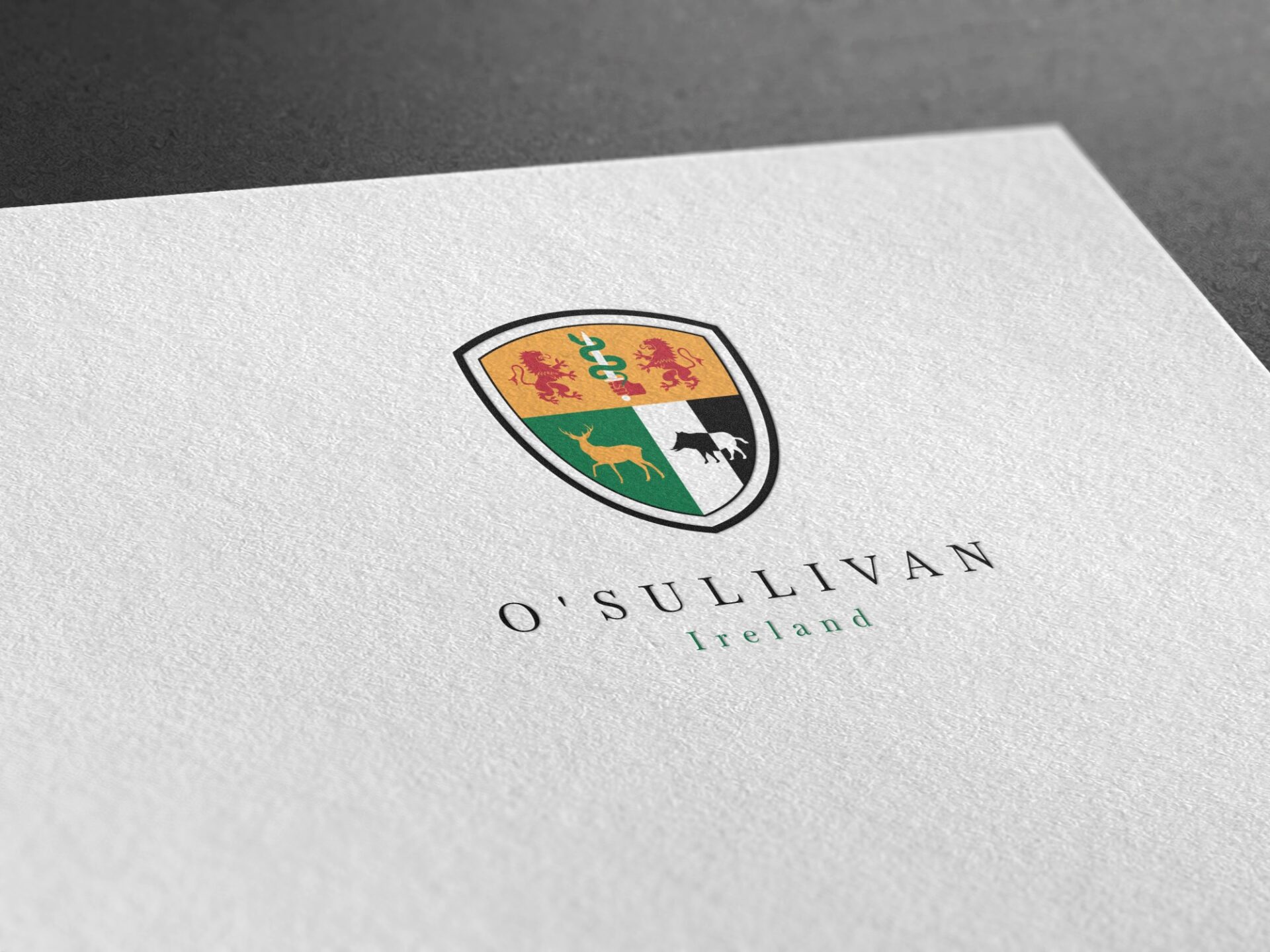

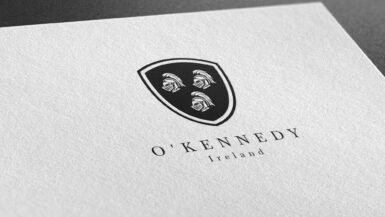
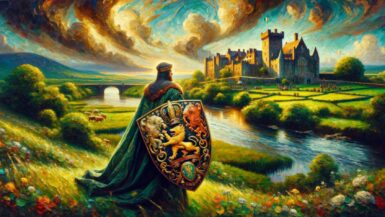
Leave a reply